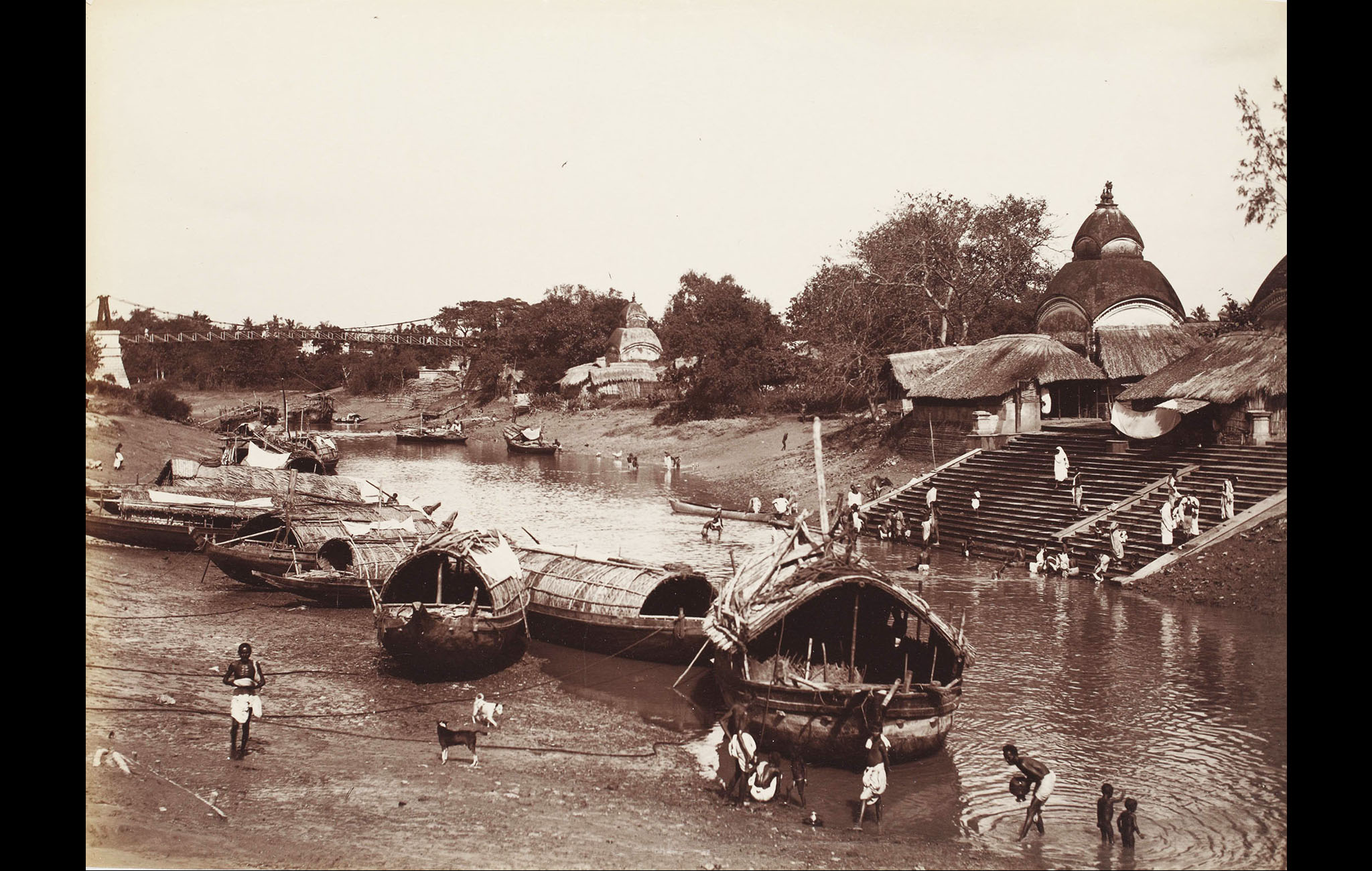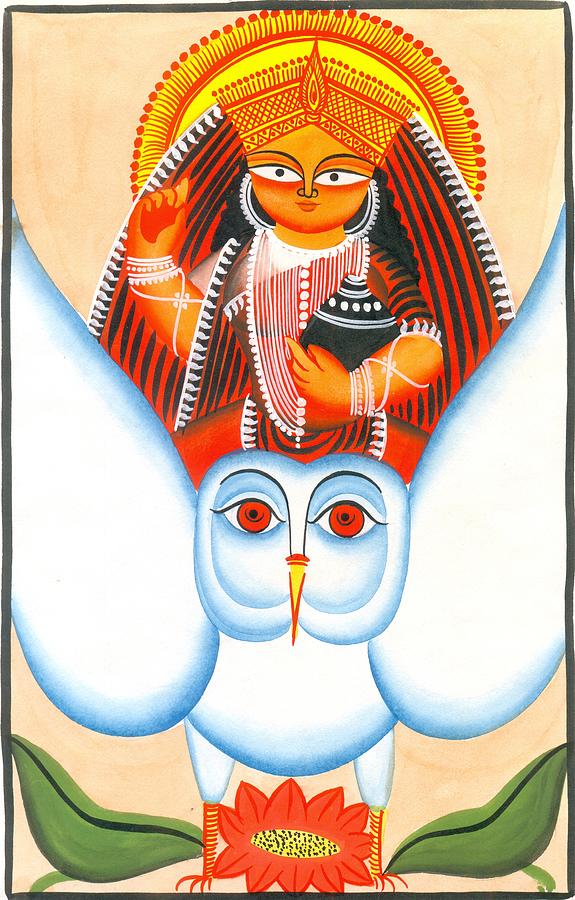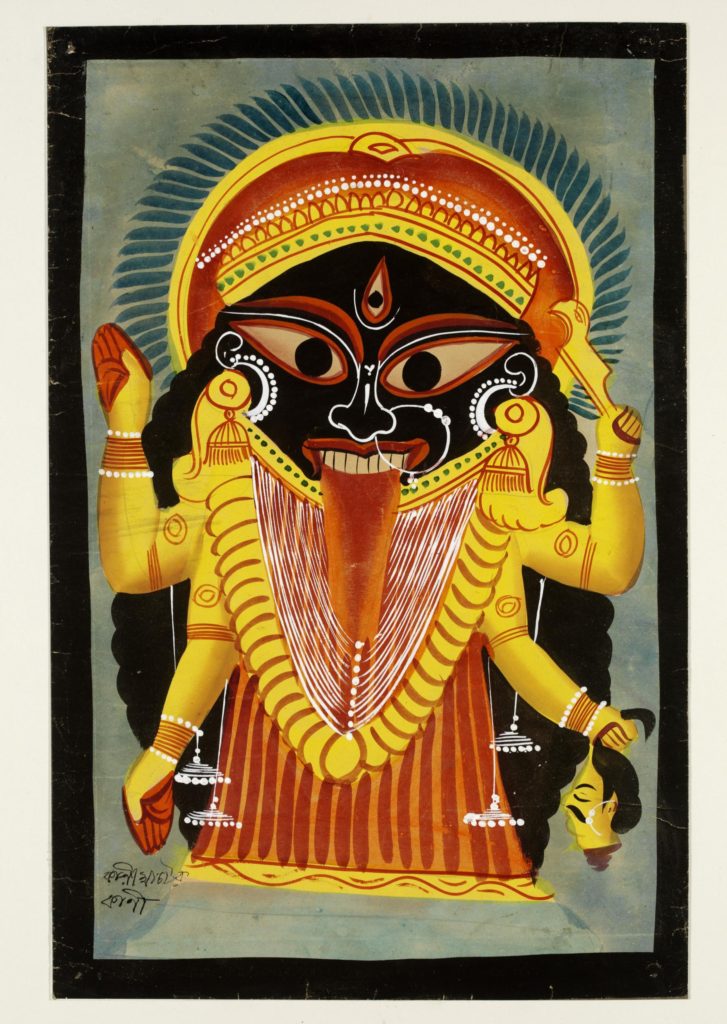Kalighat school. Group of 7 Kalighat paintings, gouache on paper, some light staining and su

Mahakali painting Kali Shiva Ma Kali Painting Gallery of gods
Born. into the Patua community of scroll painters and storytellers, Kalam Patua is a. self-taught contemporary exponent of Kalighat painting, which draws on. conventions from West Bengal scrolls and Indian miniature painting. A. postmaster in a rural post office in West Bengal, he is one of the few artists. painting in this style today. Patua's.

Story of Goddess Kali Demon Raktabija
Kalighat painting, Kalighat Patachitra, or Kalighat Pat (Bengali: কালীঘাট পটচিত্র) is style of Indian paintings which originated in the 19th century. It was first practiced by a group of specialized scroll painters known as the patuas in the vicinity of the Kalighat Kali Temple in Kolkata (formerly Calcutta ), in the.

View of the Kali Ghat, Calcutta Sarmaya
Kalighat paintings, as the name suggests, were created in the Kali Temple area on the ghat (bank) of the Burin Ganga (a canal diverging from the Ganges River) in south Calcutta (Figs. 1, 3). From at least as early as the 1830s until the 1930s, the images were painted and sold as pilgrimage and tourist souvenirs, not only in the shops and stalls lining the alleys of the Kalighat area but also.
"The Hypocrite" by Kalighat Painting by Kalam Patua. " Cat illustration, Cat art, India art
Kalighat Painting refers to the class of paintings on hand-made paper with hand-made colors produced by a group of local artists known as "Patuas".Kalighat,.

Kalighat Patachitra 3 Painting by Anwar Chitrakar Fine Art America
An easy Kalighat painting. It is a most popular Indian Folk Art painting. it is replica of Yamini Roy painting. I hope you like it. Please Like👍 Share & Sub.

Kali at Kali Ghat Painting & Wall Art Print by Raja Ravi Varma Dessine Art
Kalighat Painting. It originated in the 19th century in West Bengal, India, in the vicinity of Kalighat Kali Temple, Kalighat, Calcutta. From the depiction of Hindu gods, god, and other mythological characters, the Kalighat paintings developed to reflect a variety of subjects, including many depictions of everyday life. Paintings on the life of.

Kalighat school. Group of 7 Kalighat paintings, gouache on paper, some light staining and su
The alternate discipline of Kalighat painting, primarily known as the 'Occidental school' included Indian artworks that depicted the daily life of ordinary people, often responding to social and political changes and events affecting the locals. This contemporary painting style also captured the social evils such as crime, the hypocritical.

Souvenir Art The Divine Comedy of Calcutta’s Kalighat Paintings Sarmaya
The shading used in the Kalighat painting is a very simplified version of the highly detailed chiaroscuro shading done by western artists. Contouring through dark and light shades is done to delineate the forms and for the depiction of volume. Traditional Kalighat painting is devoid of any background. There is a specific sequence of colouring.

Kali ghat Kali maa Saraswati goddess, Kali, Kali yantra
Kalighat painting, a school of art founded in the city during the 19th century, is among those rich legacies the country continues to bask in today. Painted mostly on mill-made paper with flowing brushwork and bold dyes (often homemade), Kalighat paintings are said to have originated in the vicinity of the iconic Kalighat Kali Temple in Kolkata.

Bonhams An impressive group of 61 Kalighat paintings, depicting Hindu deities, various figures
Kalighat painting continues today in the rural districts of West Bengal. Medinipur and Birbhum are two such areas where the practice of Kalighat painting has been kept alive by contemporary artists. Using organic dyes, as the original 19th century patuas did, the paintings they create focus on secular themes and current events as well as a.

Madhubani painting shiv parvati shivshakti Madhubani painting, Madhubani art, Oil painting
Kalighat painting flourished from the early 1800s for almost a century, but fell into decline after the advent of the more easily reproducible lithograph and photograph. Eventually, the children of Kalighat painters migrated to other professions, and the last Kalighat painter is reported to have died in 1930..

Goddess Kali HD Wallpaper Free Download Kali Hindu, Hindu Art, Kali Goddess, Mother Goddess
Kalighat painting images could vary from the humble fish, which was a constant part of the meals to domesticated animals like cats. Religious forms including Durga and Krishna were regularly featured as were priests who conducted the poojas at the temples around. As a matter of fact, even gods were portrayed as ordinary people - in one.

A Zen Priest Watches as Kali Swallows the World James Ford
Kalighat painting. Ravana and Hanuman, Kalighat school of painting, c1880. Kalighat painting, or pata (originally pronounced 'pot' in Bengali) is a style of Indian painting derives its name from the place. It is characterised by generously curving figures of both men and women and an earthy satirical style.

Pin on Paintings for Home and Office
Kalighat painting was the first of its kind in the Indian subcontinent that expressed subaltern sentiment and addressed customers directly. A N Sarkar& C Mackay1 remarked that "The Kalighat school of painting is perhaps the first school of painting in India that is truly modern as well as popular. With their bold simplifications, strong lines.

Kalighat Kali Mandir Mother kali, Kali mandir, Kali hindu
Kalighat painting is a traditional Indian art form that is known for its themes, techniques, and style. Originating around the 19 th century in the Kalighat Temple area of Kolkata, the Kalighat art form has left behind a huge legacy. The mastery of the art, the bold outlines, vivid colours, and expressive depictions have been the hallmarks of the Kalighat paintings.

International Indian Folk Art Gallery
Table of Contents. Kālīghāṭ painting, short-lived style of watercolour painting produced in the 19th century in India by artists in the Calcutta marketplace for sale to pilgrims visiting the Kālīghāṭ temple. The style is characterized by broad sweeping brush lines, bold colours, and simplification of forms suitable for their mass.